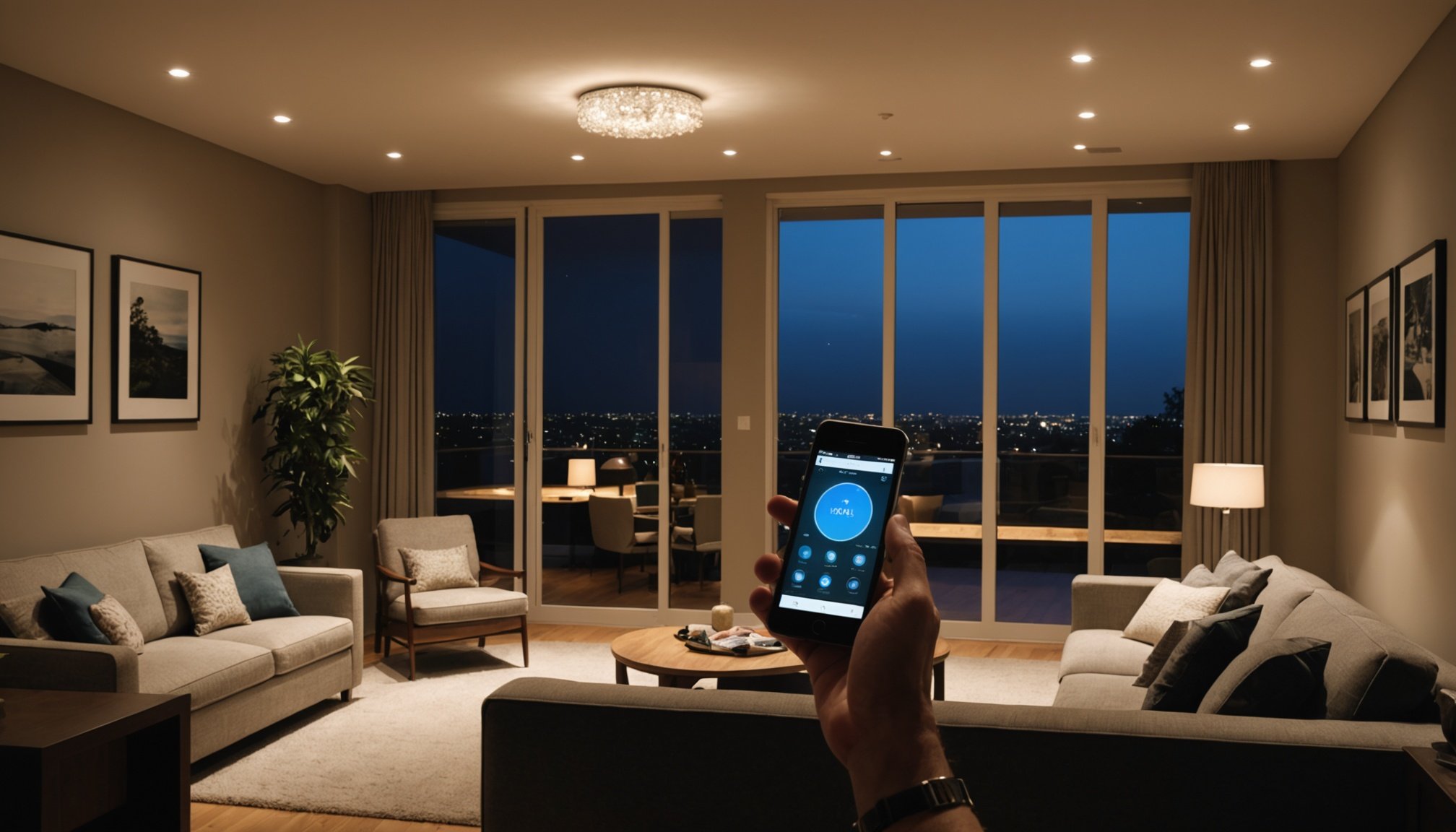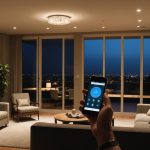Understanding Smart Home Lighting Systems
Smart home lighting has revolutionised the way we illuminate our living spaces, offering not only energy efficiency but also enhanced convenience. But what exactly makes these systems different from traditional lighting?
At its core, smart home lighting integrates home automation technology, allowing users to control lighting remotely or automatically. This transformation from manual operation to automated control means that lights can be programmed to turn on or off based on routines or environmental sensors, greatly increasing user convenience and energy savings.
In parallel : Unlocking Remote Desktop: Essential Smartphone Strategies for Flawless Connectivity
There are various types of smart lighting systems available on the market. These range from smart bulbs that screw into existing fixtures to more complex setups involving dimmers and switches wired into a home automation network. Some systems operate using apps, while others may rely on voice-activated assistants or dedicated control panels.
The integration of smart lighting with home automation is central to its appeal. Products are often compatible with larger ecosystems, such as Amazon Alexa or Google Home, enhancing their overall utility. This level of tech integration allows smart home lighting to be part of a broader intelligent home solution, increasing not just comfort but also adding security features such as simulating occupancy to deter intruders.
Also to discover : Innovative Step-by-Step: Transform Your Smartphone into a Smart Baby Monitoring System
Step-by-Step Guide to Setting Up Smartphone-Controlled Lighting
Setting up smartphone-controlled lighting can seem daunting, but breaking the process into clear steps simplifies it considerably.
Selecting the Right Smart Lighting Devices
To begin, identify smart lighting devices compatible with your current home automation setup. Compatibility is key; both the bulbs and central system need to communicate effectively. Evaluate your space—some areas may benefit from dimmable lights, while others require colour-changing options. Choose between smart bulbs or smart switches based on your needs and existing fixtures.
Installing Smart Lighting Systems
Once devices are selected, installation follows. Most smart bulbs are plug-and-play, requiring simple replacement of existing bulbs. For smart switches, you might need to consult an electrician, as these typically involve wiring changes. Ensure your Wi-Fi network can support the number of devices to avoid connectivity issues.
Connecting Devices to a Smartphone App
Post-installation, link your devices to a dedicated smartphone app. This process usually involves downloading an app, creating an account, and following in-app instructions to connect. Troubleshooting common setup issues often involves ensuring devices are on the same network and close enough to your router to maintain a stable connection. Avoid app crashes by keeping both app and device firmware updated.
Best Smartphone Apps for Controlling Home Lighting
In the realm of lighting apps, some stand out for their exceptional smartphone integration. These apps offer users seamless control over their lighting systems, enhancing daily convenience.
When exploring top-rated options, consider Philips Hue, Lutron Caséta, and TP-Link Kasa. These apps shine due to their intuitive design and robust feature sets. App comparison suggests Philips Hue excels in customization, offering advanced scene-setting capabilities. Lutron Caséta stands out for reliability and compatibility with a wide range of home automation systems. Meanwhile, TP-Link Kasa provides great value, delivering numerous functionalities at a lower price point.
Look for features such as various dimming options, compatibility with voice control like Alexa or Google Assistant, and the capacity for real-time control. User-friendly interfaces with clear navigation are also essential. Effective smartphone integration means users enjoy reliable app performance, enhancing the overall experience of managing smart home lighting.
While these apps have their unique strengths, their shared focus on enhanced functionality and ease of use makes them excellent choices for anyone looking to optimize their lighting system. Finding an app that aligns with your individual preferences and home automation goals can significantly elevate your smart home experience.
Benefits of Real-Time Control of Home Lighting
Incorporating real-time control in smart home lighting systems offers multiple advantages that transform how users interact with their environments. The initial benefit is enhanced convenience and accessibility. With real-time control, homeowners can adjust their lighting remotely, ensuring optimal lighting conditions from afar. This flexibility is a powerful tool for managing lights without being physically present, promoting ease and comfort.
Energy savings are another significant advantage. Smart lighting systems that incorporate real-time control often include energy-efficient LEDs and intelligent scheduling functionality. This combination allows for reduced utility costs by only using lights when required, minimizing unnecessary energy consumption.
Additionally, real-time control contributes to improved home security. Many smart lighting systems can simulate occupancy by automating lights to switch on or off while you’re away. This method can deter potential intruders by creating the illusion of an occupied home, adding a robust layer of security.
Overall, the tech integration inherent in smart lighting systems elevates their usefulness by merging comfort, energy efficiency, and security. Users can feel empowered by the home automation solutions that facilitate a modern and proactive approach to home management.
Maximizing Functionality of Your Smart Lighting System
Smart lighting solutions provide a realm of possibilities for tailoring your home environment, but to get the most out of them, thoughtful customization and integration are essential.
Customizing Lighting Scenes and Schedules
Personalizing lighting scenes and schedules allows your smart lighting system to align with your lifestyle and preferences. Whether it’s a warm, relaxing glow for an evening in or a vibrant ambiance for gatherings, setting specific scenes for different occasions enriches your home experience. Use the system’s scheduling feature to automate these scenes based on the time of day or activity, ensuring seamless transitions throughout your day without manual intervention.
Integrating Voice Control Options
One of the standout features of smart lighting is its compatibility with voice control systems like Amazon Alexa or Google Assistant. Integrating these can offer a hands-free lighting experience. Whether you’re busy cooking or entering a room with your hands full, a simple vocal command can adjust your lighting instantly. This is not only convenient but adds a futuristic touch to daily routines.
Creating Smart Lighting Routines
Designing smart lighting routines advances both the safety and convenience of your home. By automating lights to turn on and off at scheduled times, you can simulate occupancy when you’re away, adding a layer of security. Scheduling routines for outdoor and indoor lights ensures that pathways and spaces are always well-lit when needed.
Overcoming Common Challenges with Smart Lighting
Smart home lighting brings numerous benefits, yet challenges like troubleshooting smart lighting and installation problems can occur.
Common issues often involve connectivity. Ensuring your home automation system is compatible with your network and devices is crucial. If connectivity problems persist, a common solution includes checking Wi-Fi strength and considering a signal booster to support multiple devices.
Another frequent challenge is troubleshooting smart lighting that does not respond to apps. Here, it’s vital to verify that device firmware is up-to-date. Sometimes, ensuring all devices are on the same network resolves issues effectively. For stubborn problems, a savvy move is reconfiguring the network settings or reaching out to customer support for guidance.
Installation woes typically arise with smart switches that seem incompatible with existing wiring. To avoid installation problems, consult an electrician, especially if wiring changes are needed. An overlooked aspect is double-checking compatibility between smart lighting devices and the apps intended for control. Ensure the software supports the specific capabilities of your smart lighting system, mitigating compatibility hiccups.
By proactively addressing these common issues, the joy of intuitive tech integration in your smart home can be fully realised.
Product Reviews and Comparisons
Exploring smart lighting products can offer invaluable insights, but comparing features, prices, and user experiences is crucial.
When diving into product reviews, you’ll find that popular options like Philips Hue and LIFX excel in flexibility and colour range. Philips Hue offers robust ecosystem compatibility, making it a favourite for those well-integrated with home automation. Meanwhile, LIFX distinguishes itself with high brightness levels and vibrant colours, ideal for lively lighting setups.
Price points vary significantly across brands. While high-end smart devices often promise extensive features, budget-friendly alternatives like the Wyze Bulb deliver impressive efficiency without hefty costs. These choices are well-suited for those initiating their smart home journey.
User experiences often highlight usability as a critical factor. Products that offer intuitive apps and seamless integration stand out. For instance, TP-Link Kasa remarkably balances cost-effectiveness and ease of use, catering to smaller homes or those seeking straightforward setups.
It’s essential to match your lighting needs with your budget, considering energy efficiency and tech integration. Thorough comparisons help ensure that your smart lighting choice aligns with your home’s requirements, providing both function and an aesthetically pleasing atmosphere.
DIY Solutions for Enhancing Smart Lighting
In the realm of DIY smart lighting, creativity and resourcefulness can significantly enhance home environments.
Creating Your Own Smart Lighting Switches
For those with a knack for technology, building custom lighting switches can be an enriching experience. Arduino boards or Raspberry Pi systems serve as excellent platforms for crafting homemade switches. These projects not only foster innovation but also allow tailored control options, creating unique solutions for individual needs.
Integrating Smart Lighting with Other Home Tech
Combining smart lighting with existing home automation tools magnifies their utility. By syncing lights with a smart thermostat, you can optimize energy use. For example, decrease light intensity when the thermostat detects lower temperatures. This tech integration facilitates a cohesive, efficient home environment, enhancing both comfort and convenience.
Upcycling Traditional Lighting Fixtures
Upcycling old fixtures into smart systems is a practical and sustainable approach. Retrofit existing lamps with smart bulbs or add motion sensors to traditional lights. This process respects the aesthetic value of older designs while incorporating modern functionalities, offering a seamless blend of old and new that enriches home environments with sophisticated lighting automation capabilities.











